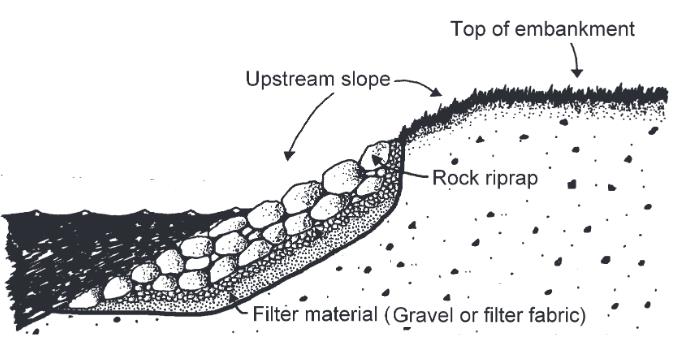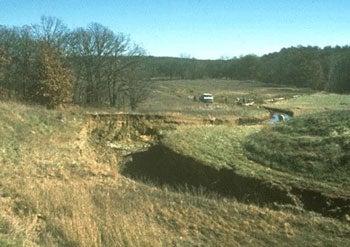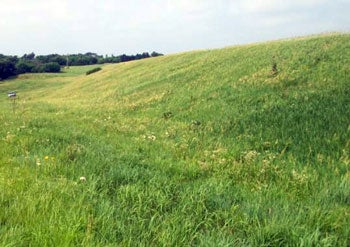- Overgrazing, poor weed control, concentrated runoff, and wave erosion are all common causes for poor vegetative cover and erosion on a dam.
- Bare soil or sparse vegetative cover are especially susceptible to damage and erosion.
- Heavy rainfall, high winds, and flood events can cause extensive damage and costly repairs to unvegetated areas.
- In spillways, lack of grass cover, obstructions, and concentrated runoff can lead to erosion.
- Once erosion begins in the spillway, the erosion can grow quickly in size during a large flood and result in dam failure.
- Over time, wave action will erode unprotected earthen slopes decreasing the width of the dam.
- Waves can erode soil through holes between large pieces of riprap.
- In earthen spillways, farming, livestock grazing, and vehicle paths remove protective grass cover.
- Lack of grass cover can lead to massive erosion and dam failure when water flows through the spillway.
|
- Areas of sparse vegetation should be reseeded with perennial grasses each spring or fall.
- Control weeds by mowing or application of herbicides.
- If erosion is detected early, add protective grass vegetation that may resolve the problem.
- It is best to keep livestock from grazing on earthen dams and in vegetated spillways. At a minimum, livestock grazing should be extremely limited. Protect areas by installing fencing. Fences should not be installed across spillways where the flow velocities could be high.
- Redirect surface runoff away from steep areas by constructing swales and terraces.
- Check for erosion in earthen spillways after major storm events.
- Reestablish the normal embankment slope by placing compacted soil in eroded areas.
- Place filter material such as crushed rock, gravel, or filter fabric under rock riprap to prevent wave erosion.
- Do not plant crops in vegetated, earthen spillways.
- Do not create paths by repeatedly driving vehicles over the same path through the spillway.
|






